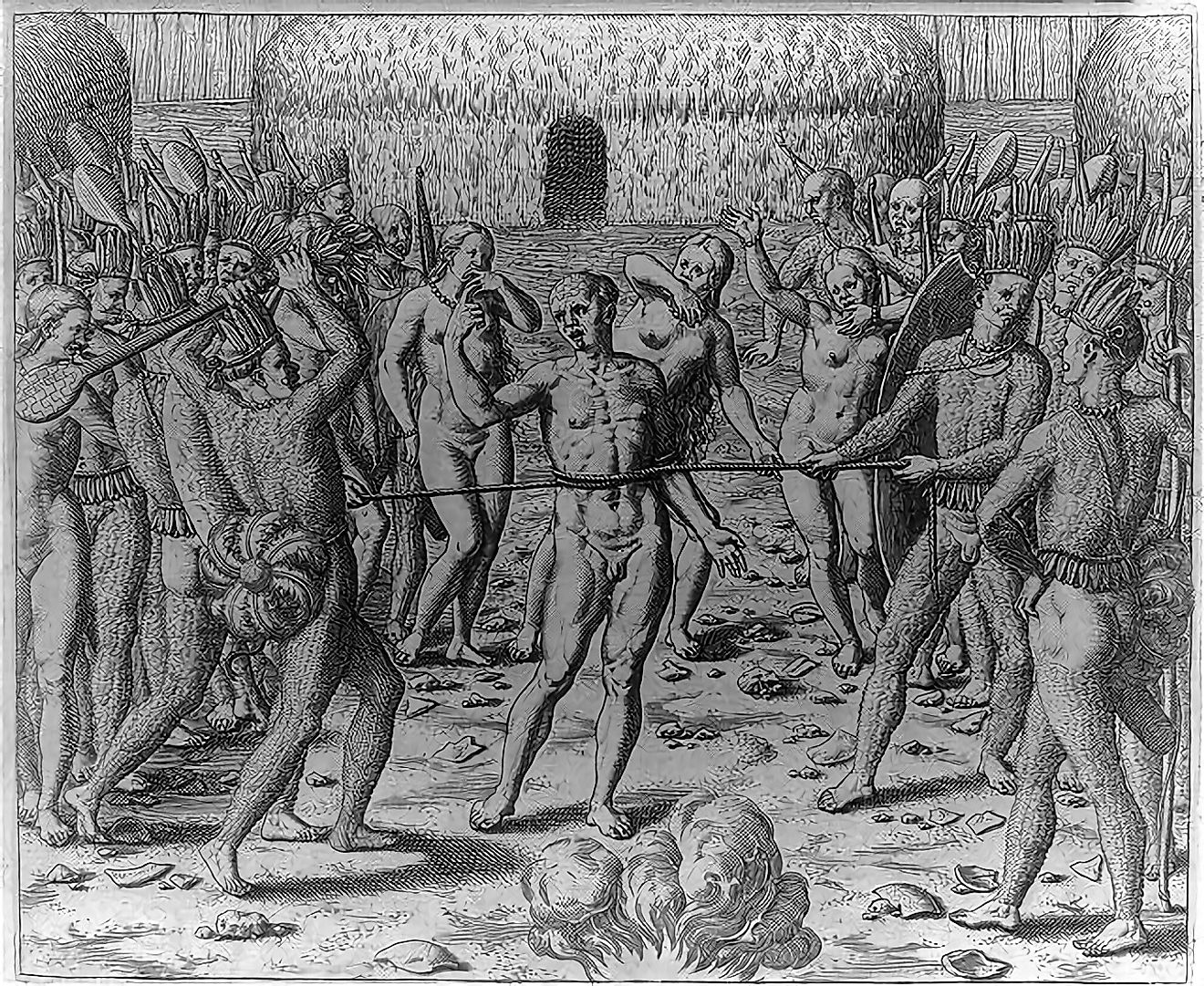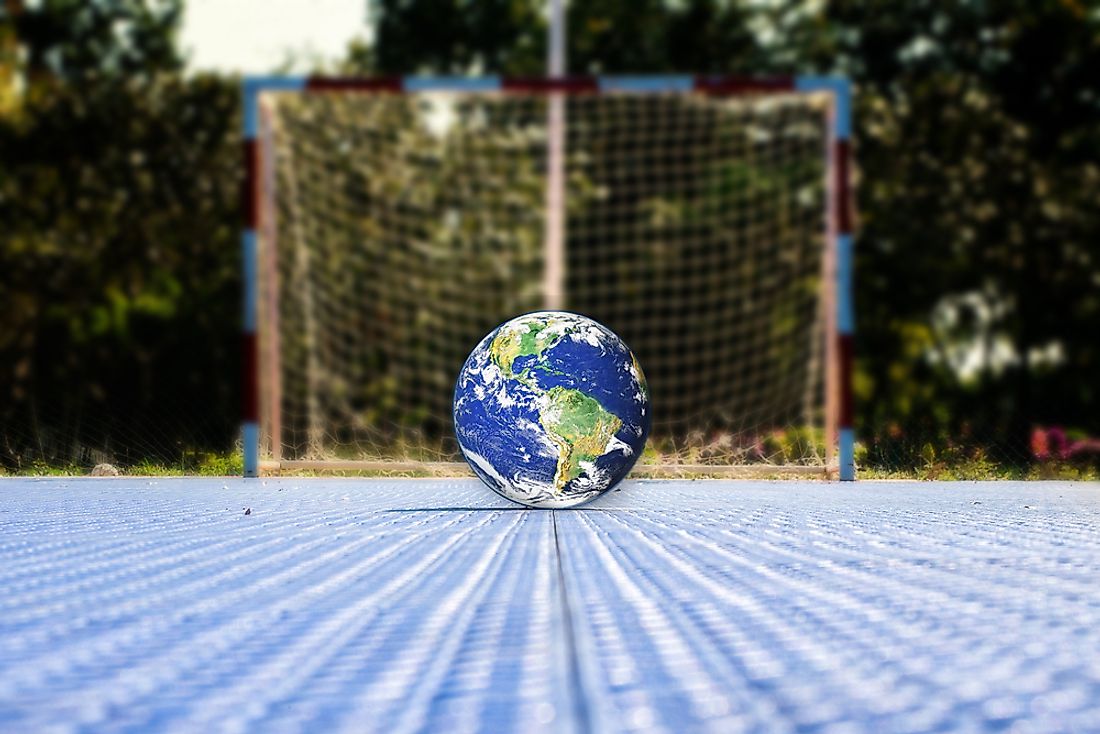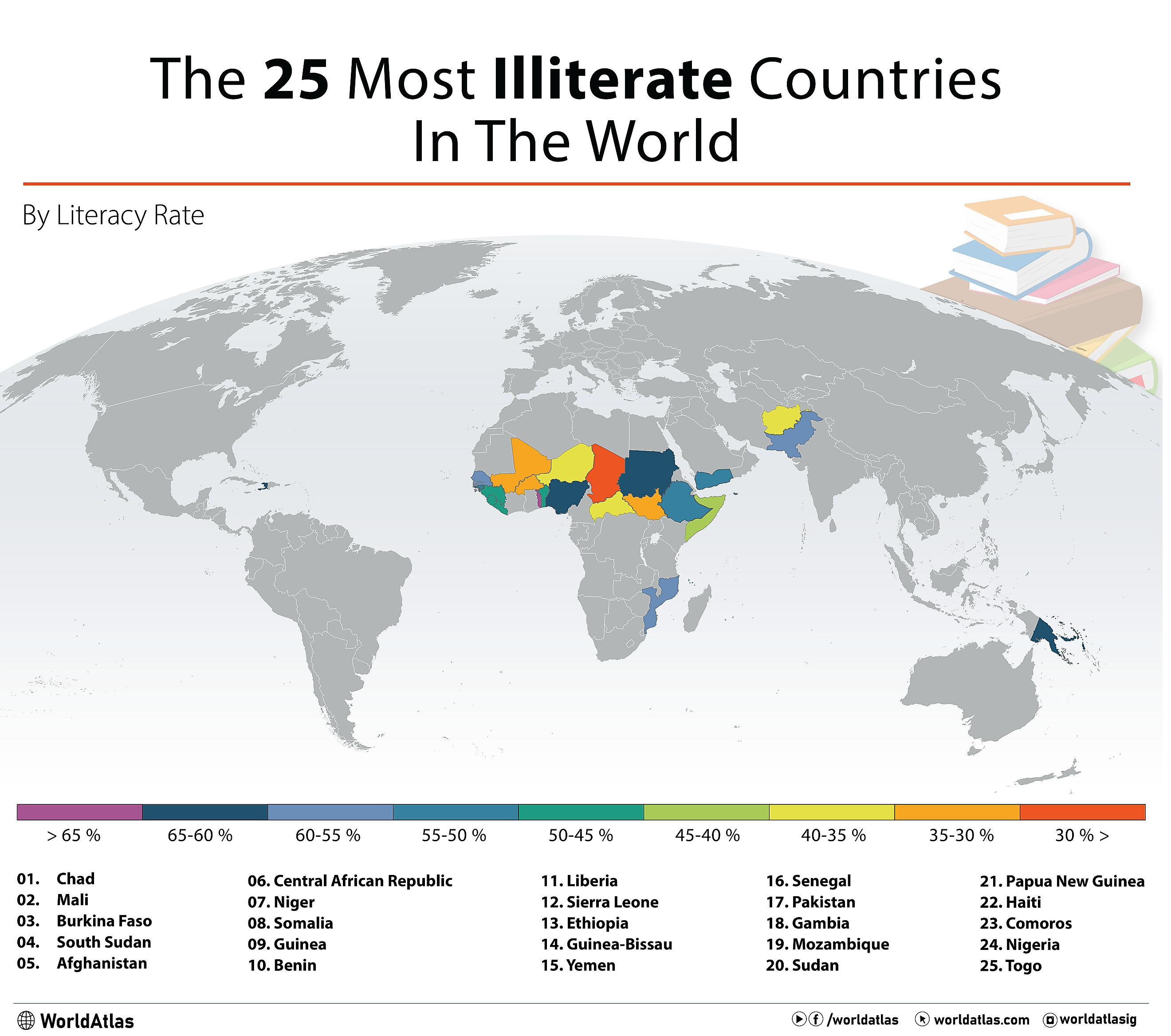
25 Most Illiterate Countries
In the past two centuries, literacy on a global level has skyrocketed, from just 12% of adults literate in 1820, to 87% worldwide today. However, despite this global movement towards literacy, many countries continue to struggle, challenged by social problems such as poverty, inequality, and corruption. Countries in sub-Saharan Africa are some of the most affected, with fewer than one in three adults in this region able to read and write. Currently, Chad, Mali, Burkina Faso, South Sudan, Afghanistan, Central African Republic, Niger, Somalia, Guinea, and Benin are some of the countries with the lowest literacy rates in the world.
10 Of The Most Illiterate Countries In The World
| Rank | Country | Literacy Rate |
|---|---|---|
| 1 | Chad | 27.28% |
| 2 | Mali | 30.76% |
| 3 | Burkina Faso | 34.49% |
| 4 | South Sudan | 34.52% |
| 5 | Afghanistan | 37.27% |
| 6 | Central African Republic | 37.49% |
| 7 | Niger | 38.10% |
| 8 | Somalia | 41.02% |
| 9 | Guinea | 45.33% |
| 10 | Benin | 47.10% |
Click Here To Jump To The Full Table: The 25 Most Illiterate Countries In The World
1. Chad - 27.28%
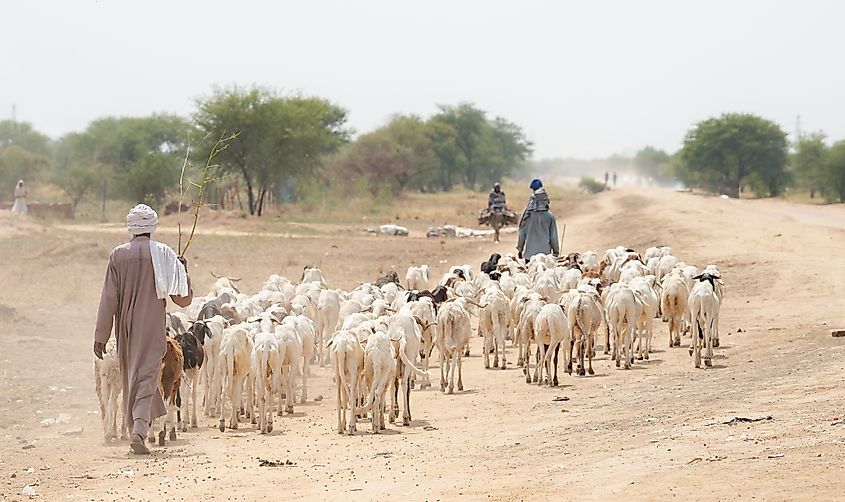
Although the government is attempting to prioritize education in Chad, many challenges continue to impede the development of the school system. UNESCO reports that about 75% of students are taught by teachers without education beyond the secondary level, partly due to Chad’s little access to higher education, professional training, and technical education. The country has also received over 600,000 refugee children from Nigeria, the Central African Republic, and Sudan, which has even further overwhelmed the school system. In fact, only about 20% of students who conclude their primary education studies have a solid foundation in reading and math.
2. Mali - 30.76%
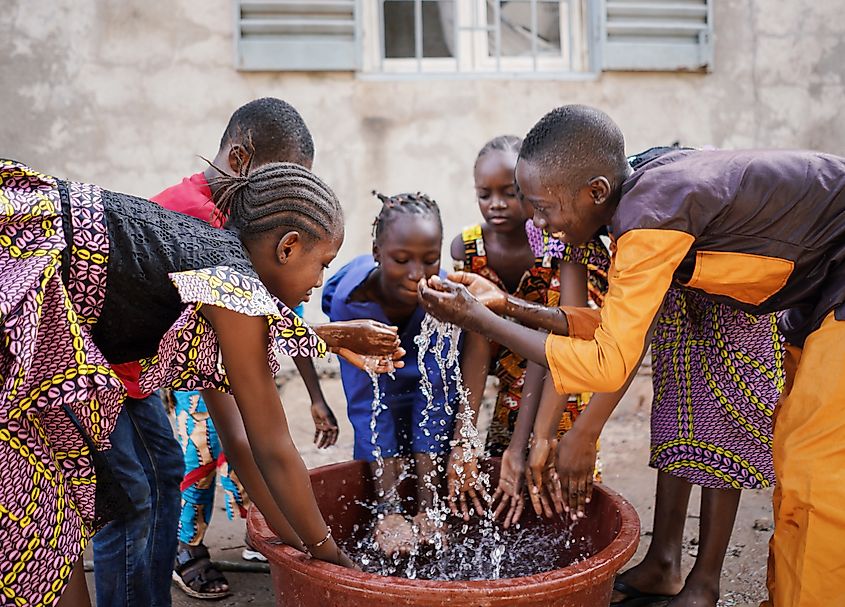
Although Mali has been seeing improvements in its education system over the past decade, more than two million children of school age do not attend school. The dropout rate is extremely high in the country, largely due to social factors such as household poverty, child marriage, child labor, insecurity, and a shortage of schools near children’s homes. Those who do attend school face challenges such as a lack of qualified teachers and low quality of the educational environment, resulting in the majority of students concluding fifth grade not being able to master basic reading and math skills.
3. Burkina Faso - 34.49%
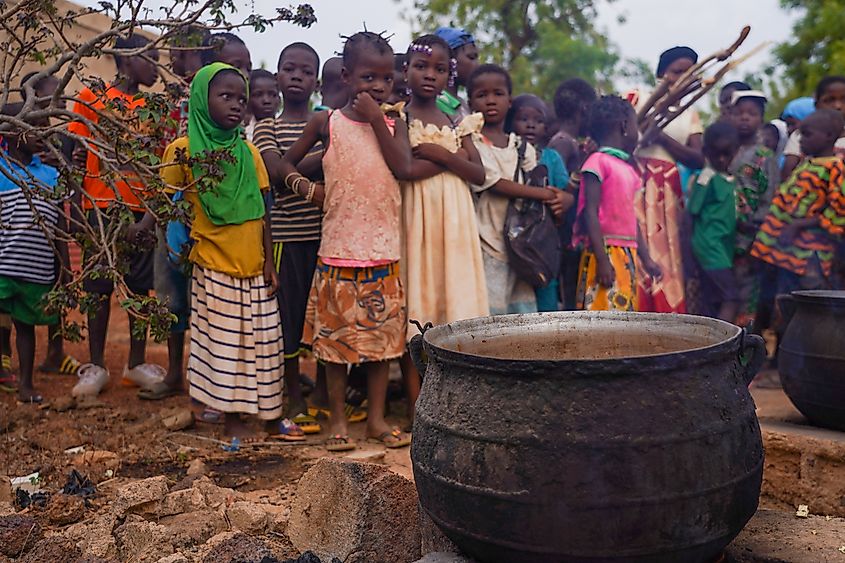
Burkina Faso has the third lowest literacy rate in the world, largely due to problems in the education system, such as overcrowded classrooms and high student-to-teacher ratios. There is also a large amount of geographical inequality, with school attendance rates five times lower in rural areas than around the capital metropolitan region. The country’s government is taking steps to raise the literacy rate by implementing a national literacy program, offering education and literacy training to those who did not attend school or dropped out, and improving educational opportunities for girls.
4. South Sudan - 34.52%
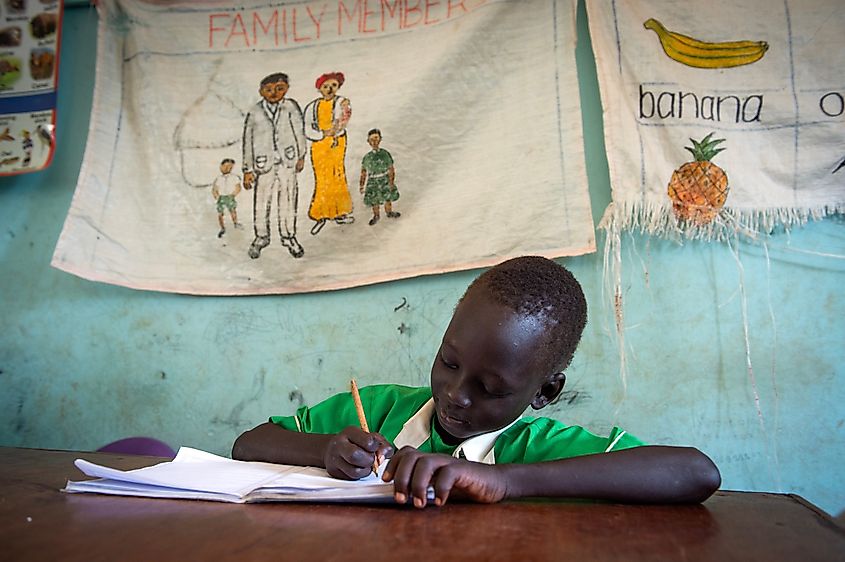
South Sudan's literacy rate of 34.52% is significantly impacted by challenges within its educational system. These challenges stem from poverty, violence, insufficient political leadership, and a shortage of qualified teachers. The lack of qualified educators is exacerbated by unclear career paths, inadequate formal training, and inconsistent payments, causing many to seek more stable and better-paying employment. During the country’s civil war in 2013, armed groups also recruited over 19,000 to join their militias, resulting in a massive dropout of students that continues to affect the country today. Additionally, widespread violence, humanitarian crises, flooding, and exacerbating poverty continue to keep many children out of school.
5. Afghanistan - 37.27%
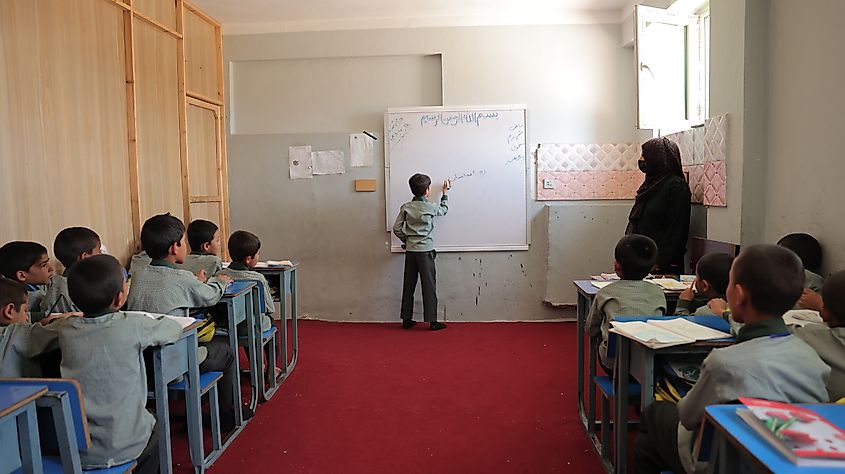
Over three decades of conflict in Afghanistan continues to have a long-lasting impact on the country’s education and literacy rate. Rural and poorer regions of the country face even greater challenges with school attendance. Geographic barriers, such as mountains and long walks, prevent many children from attending school. Afghanistan’s challenged educational system and lack of literacy especially affects girls, who represent over 60% of the country’s out-of-school children. The country's insecurity, traditional role for women, and child marriages are largely responsible, with 17% of girls getting married before they are 15.
6. Central African Republic - 37.49%
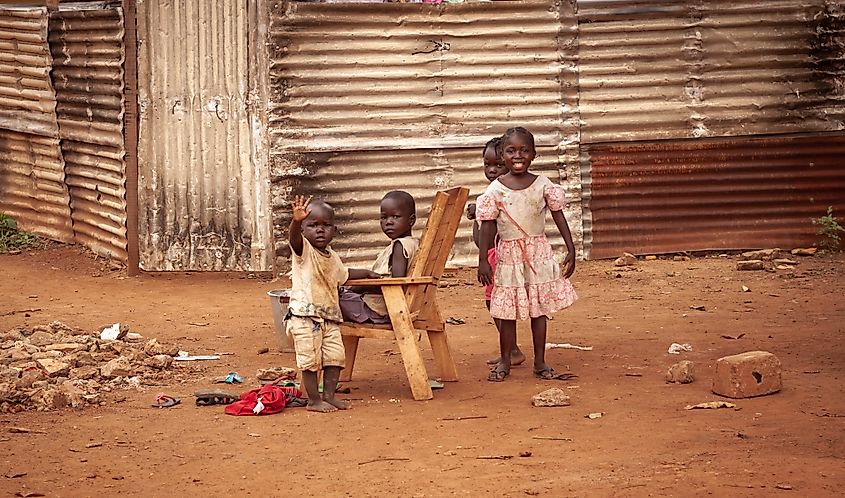
Corruption, a lack of qualified teachers, violence, and unequal access to education have all contributed to the Central African Republic’s literacy rate of 37.49%. Former Minister for Education, Gisèle Bedan, said that the department was nearly impossible to run, largely due to corruption in the sector. Deaths caused by the AIDS epidemic have taken a toll on teacher numbers over the past few decades as well, with over 100 primary schools closing at the end of the 20th century. Girls are also much less likely to be fully literate, with only 23% of girls enrolled after their sixth year of schooling.
7. Niger - 38.1%
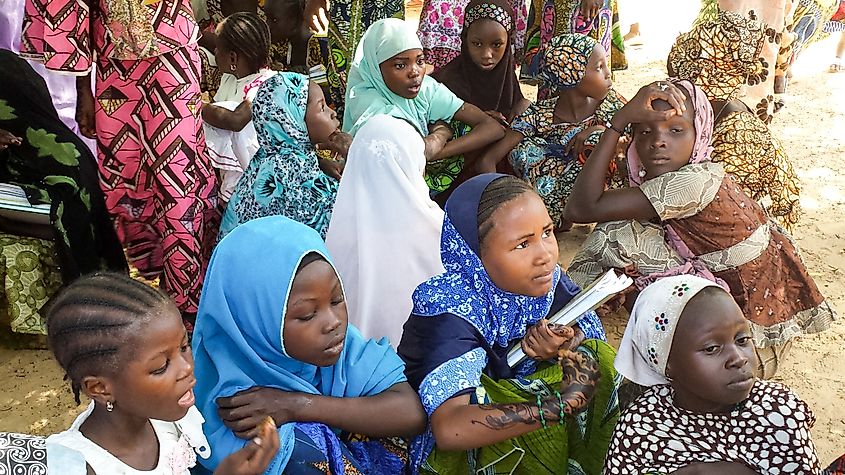
Although Niger has been investing in the education system to maintain school enrollment, with about 20% of the state’s budget going towards the education sector, education levels continue to be low. Although it is compulsory for students to attend school between the ages of seven and fifteen, over half of the students in this age range do not, largely because of poor retention rates, poor school quality, and geographic gaps, with far fewer children in rural areas attending classes. Of the children that do attend school, only 8% have adequate reading and math skills after finishing the primary level.
8. Somalia - 41.02%
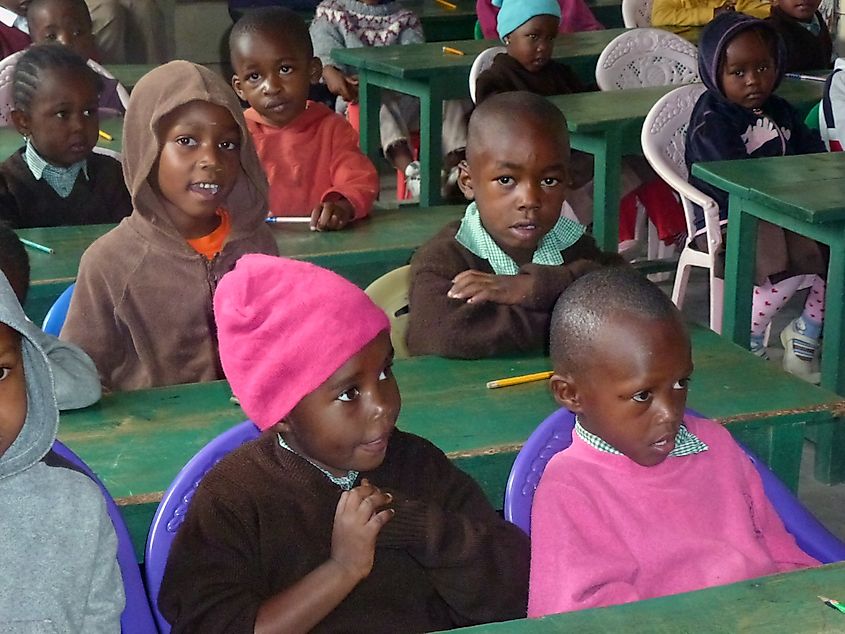
Although the literacy rate in Somalia has greatly increased since the 1970s, the country continues to face many difficulties with its education system. Over three million children in Somalia do not attend school. Many families cannot afford their children's education, and many children live far from the nearest school. Those who can enroll their children often decide not to due to safety concerns, inadequate sanitation facilities, a lack of teachers, and overcrowded classrooms. Many children also live in nomadic pastoral communities, unable to acquire a formal education due to constant movement.
9. Guinea - 45.33%
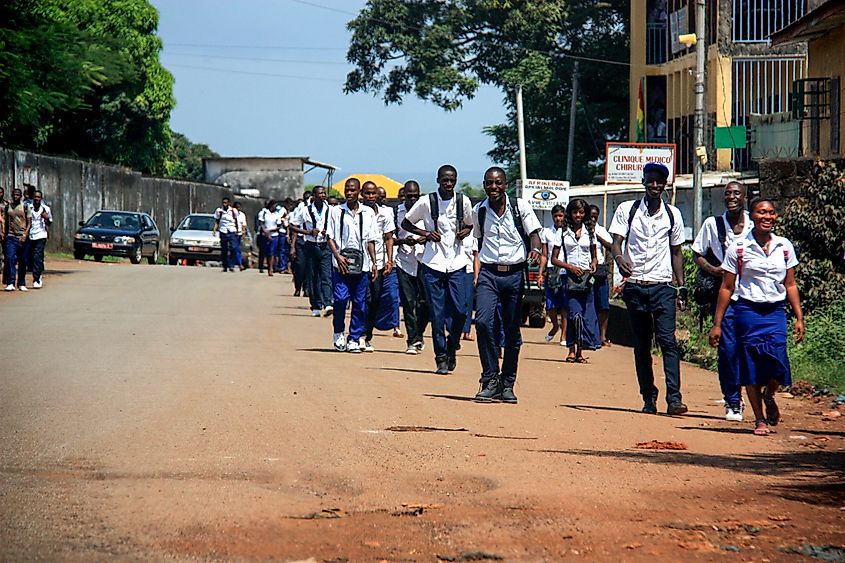
Guinea’s literacy level varies greatly depending on gender. While over 60% of men have adequate literacy skills, just over 30% of women can read and write. This literacy gap has also impacted the gender gap in the workforce, with the number of working women declining since 1990. Many of the children who are enrolled in school face inadequate school conditions. Approximately 98% of students in primary school, for example, are learning poor, meaning that an improvement in the school system is needed in order for the literacy rate to rise.
10. Benin - 47.1%
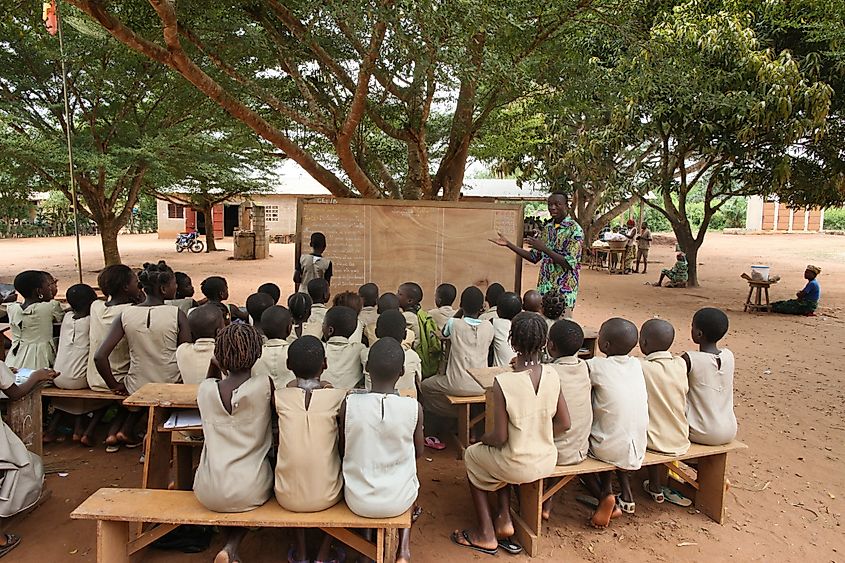
Benin, with a literacy rate of 47.1%, has been making changes to the education system over the past few decades. In 2007, they abolished school fees, making education free for all students. The student-to-teacher ratio has improved since 1997, decreasing from 53 students per teacher to 39 students per teacher. However, child labor, child marriages, poverty, and early pregnancy continue to contribute to early dropout rates. Misuse of the budget also contributes to Benin’s difficulties, with the country achieving only 58.8% of what it should be able to achieve at the secondary level based on income and resources.
Final Thoughts
In many of these countries, challenges like a shortage of teachers and resources, traditional gender norms that keep girls out of school, and a scarcity of rural schools all continue to affect their literacy rates. In many cases, those who can attend school still struggle to land at the expected literate level. However, many countries, such as Benin, Niger, and Burkina Faso, have been investing time and resources into schooling, with the hopes of creating a better future for the next generations. Although significant challenges remain, the efforts of these countries, along with support from foreign aid groups and nonprofit organizations, will hopefully result in the improvement of educational outcomes and literacy rates over time.
The 25 Most Illiterate Countries In The World
| Rank | Country | Literacy Rate |
|---|---|---|
| 1 | Chad | 27.28% |
| 2 | Mali | 30.76% |
| 3 | Burkina Faso | 34.49% |
| 4 | South Sudan | 34.52% |
| 5 | Afghanistan | 37.27% |
| 6 | Central African Republic | 37.49% |
| 7 | Niger | 38.10% |
| 8 | Somalia | 41.02% |
| 9 | Guinea | 45.33% |
| 10 | Benin | 47.10% |
| 11 | Liberia | 48.30% |
| 12 | Sierra Leone | 48.64% |
| 13 | Ethiopia | 51.77% |
| 14 | Guinea-Bissau | 53.90% |
| 15 | Yemen | 54.10% |
| 16 | Senegal | 57.67% |
| 17 | Pakistan | 58.00% |
| 18 | Gambia | 58.67% |
| 19 | Mozambique | 59.78% |
| 20 | Sudan | 60.70% |
| 21 | Papua New Guinea | 61.60% |
| 22 | Haiti | 61.69% |
| 23 | Comoros | 61.71% |
| 24 | Nigeria | 62.02% |
| 25 | Togo | 66.54% |



